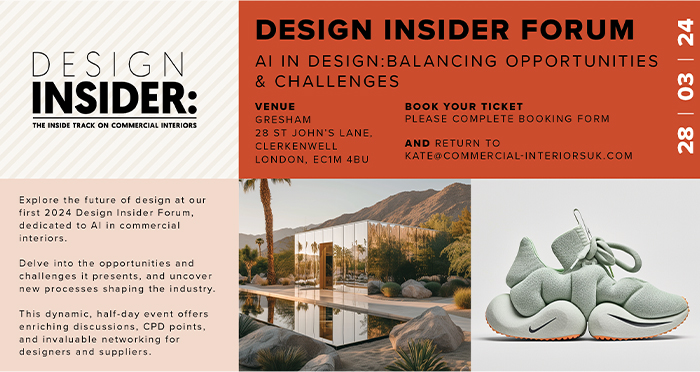Understanding the complex nature of luxury in hospitality design is vital for the commercial community because it directly aligns with our collective goal to create spaces where people feel welcome, comfortable, and where their expectations are not just met but exceeded.

Design Insider facilitated a CPD accredited in-depth conversation with two of the commercial interiors sector’s most influential figures: Jim Hamilton, Creative Director at Graven Images, and Nicolle Cairney, Associate at 3DReid. Led by Design Insider’s Editor, Alys Bryan, the dialogue aims to explore and ‘define luxury’ in the context of modern commercial interiors, particularly within the hospitality sector.
The discussion expanded on 6 areas of interest:
1. Defining Luxury in Hospitality: Explore the essential criteria that distinguish genuine luxury in the hospitality sector, focusing on how to identify and classify truly luxurious spaces and services.
2. The Impact of Exceptional Service: Discuss the transformative power of exceptional service in luxury hospitality, including real-world examples where service excellence has elevated the guest experience.
3. Sustainability and Luxury in Design: Examine the intersection of sustainability and luxury, highlighting innovative materials and design practices that allow for the creation of spaces that are both opulent and environmentally responsible.
4. Technology's Role in Luxury Hospitality: Delve into the integration of technology in luxury hospitality, identifying how it can enhance efficiency and the guest experience without compromising the personal touches that define luxury.
5. Bespoke Design in Luxury Hospitality: Analyse the significance of bespoke design in establishing luxury, addressing how designers navigate the challenges of customization within budgetary and time constraints.
6. Interdisciplinary Approach: Consider how the scope of commercial interior design has expanded to encompass architecture and branding, and how this interdisciplinary approach influences the development of luxurious, cohesive projects.
The key outcomes of the conversation were:
Differentiating True Luxury in Hospitality
True luxury in hospitality transcends mere aesthetic appeal, embodying exclusivity, personalized experiences, and impeccable quality. Graven, for example, emphasizes the importance of storytelling and authenticity, designing spaces that reflect the unique character and heritage of their location. A genuinely luxurious space or service is distinguished by its attention to detail, bespoke elements, and the ability to offer guests a seamless, unforgettable experience.
The Role of Exceptional Service in Luxury Experiences
Exceptional service is fundamental in transforming a high-end space into a luxurious experience. It's about anticipating guest needs and offering personalized, discreet services that make guests feel valued and pampered. Examples include personalized welcome messages, tailored concierge services, and attentive but unobtrusive staff interactions. Graven's projects often integrate elements that facilitate outstanding service, from intuitive guest room layouts to sophisticated lounge areas that encourage interaction yet ensure privacy.
Reconciling Sustainability with Luxury
Sustainability and luxury are not mutually exclusive; in fact, sustainable practices can enhance the luxury of a space. Designers like those at 3DReid are leading the way by using renewable materials, energy-efficient designs, and locally sourced products that reduce environmental impact without compromising on quality or aesthetics. Incorporating natural elements, sustainable wood, and recycled materials, along with employing green building practices, can create luxurious spaces that are both elegant and environmentally responsible.
Incorporating Technology into Luxury Hospitality
In the luxury hospitality sector, technology should enhance, not replace, the human touch. Essential technologies include seamless connectivity, intuitive room controls, and personalized entertainment systems that offer convenience without being intrusive. 3DReid's approach often involves integrating technology discreetly into their designs, ensuring that it serves to elevate the guest experience by making interactions smoother and more personalized, rather than detracting from the luxury ambiance.
The Importance of Bespoke Design in Luxury Hospitality
Bespoke design is crucial in defining luxury by offering uniqueness and personalization that cater to the discerning tastes of guests. While bespoke elements can indeed raise costs and extend development times, designers manage these challenges by prioritizing key personalized touches that significantly impact the guest experience. Strategic planning, phased implementations, and selective customization allow for balancing bespoke luxury with budget and timeline constraints.
The Expanded Scope of Commercial Interior Design Studios
The scope of Commercial Interior Design Studios has indeed broadened to include architecture and branding, fostering a more holistic approach to creating luxury projects. This interdisciplinary convergence enhances the ability to deliver cohesive luxury experiences by ensuring consistency in design, narrative, and brand identity across all touchpoints. Graven and 3DReid exemplify this approach, leveraging their cross-disciplinary expertise to overcome challenges and create integrated, immersive environments that resonate with luxury on every level.
Additional resources:
designinsiderlive.com
commercial-interiorsuk.com
graven.co.uk
3dreid.com
Attendance to this conversation earns 1 CPD point. Please download your CPD Certificate here.